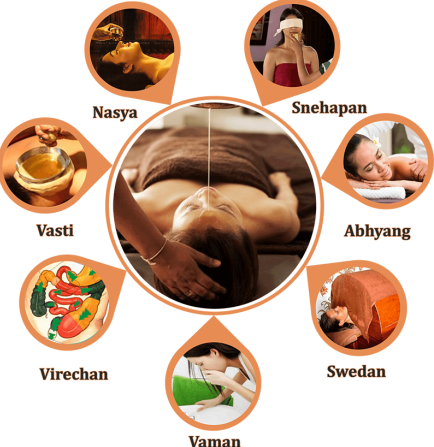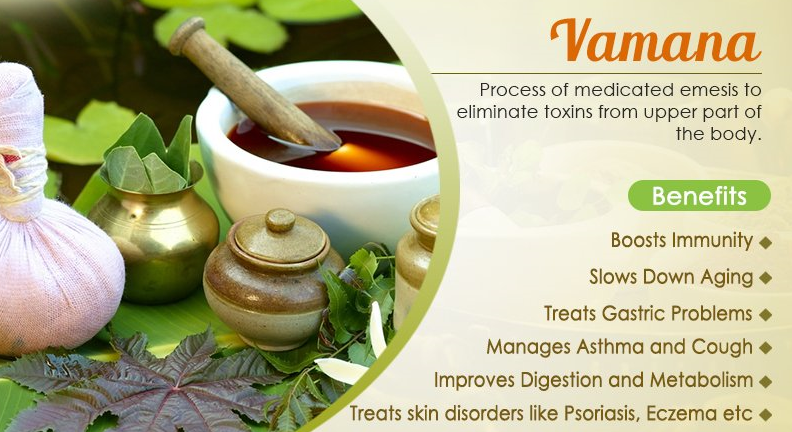Abhyangam is an Ayurveda classical massage therapy that uses warm, medicated oils. It differs
The word Bashpa refers to steam. Bashpa sweda is a sudation therapy where the steam is given with the
The word panchakarma means “five actions / procedures” (pancha means 5, karma means
Vasti (Enema) treatments are extremely effective in removing Vata-based toxins from the system. There are two different
Putapaka is a procedure where lukewarm medicated juice (swarasa) prepared with the help of putapaka
Leech therapy is a method in which the localized impure blood is let out using
leeches.
The nasal canal provides a link to the brain. In Nasya Therapy, this channel is utilized to deliver
Nasa dhoomapana, the term comprises of two different words Nasa (which means nose) and Dhoomapana (which indicates
Nadi sweda is a unique form of Swedana procedure, where perspiration is induced by passing steam over the whole body or
Kati vasti is a specialized Ayurvedic therapy used to treat various ailments like Musculo-skeletal disorders

Pentads are the five mandatory Ayurvedic therapies performed during Panchakarma.
A variety of rejuvenation therapies have been prescribed by different Ayurvedic schools of research. They are classified into a set of five methods called the Panchakarma.
The five major therapies outlined by the Charaka school of Ayurveda are:

Later, Sushruta, the legendary surgeon, and his school of Ayurveda combined the last two Vasti (Enema) techniques into one, and added Raktamokshana (blood-letting) to the Pentads of Panchakarma. He believed that since impurities in blood are a major cause of illness in their own right, including a technique to purify blood in the Panchakarma is important. Vamana Vamana Chikitsa, or Emesis Therapy, involves controlled, medically-induced vomiting. It is aimed to eliminate excess Kapha Dosha in the body which can otherwise trigger a series of ailments like acne, asthma, arthritis, chronic cold and diabetes. It is not advisable to give this treatment to children, the elderly, pregnant women or people suffering from tuberculosis or hepatitis. Initially, the patient is given Purvakarma, or preparatory therapy, for three to seven days. Both internal and external oleation are done with medicated ghee or oil and the patient is made to sweat intensely. This directs the excess Kapha to build up in the stomach. Afterwards, Pradhanakarma, or main therapy, is given to expel excess Kapha from the body. Patients are made to consume items such as black gram and sesame that increase Kapha, and herbal concoctions like Madana (Randia Dumetorum) to induce vomiting. Usually, expulsion of Kapha begins within 30 minutes of ingestion, and the emesis subsides on its own after six to eight such episodes. Paschatkarma, or rehabilitative treatment, is prescribed after Pradhanakarma. The patient follows a special diet, avoids loud speech and exposure to sunlight, and takes adequate rest.
Virechana
Virechana Chikitsa, or Purgation therapy, is the elimination of toxins from the body using herbal laxatives. The resulting bowel movement rids the system of harmful Pitta-related impurities. Organs in the lower torso small intestine, kidney, colon, liver, and spleen – are cleansed during this therapy.
Before Virechana, Purvakarma, or preparatory treatment, is given for a week using medicated ghee or oil. After this oleation therapy, the patient is made to sweat intensely to isolate the corrupt doshas in the system.
During Pradhanakarma, or main treatment, the patient is usually administered natural laxatives like Trivrit (Ipomoea Turpethum), Jayapala (Croton Tiglium), Aragvadha (Cassia Fistula) and Avipathi Churna. The laxative effects kick in within two hours of consumption of the herbs.
When performed correctly, Virechana does not trigger the usual side effects of diarrhoea, such as weakness and loss of electrolytes. This is recommended for the treatment of diabetes, colitis, jaundice, spleen enlargement, arthritis, dysuria, asthma, hemorrhoids (piles), glaucoma and gout.